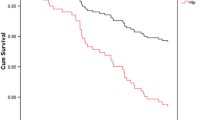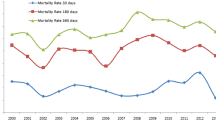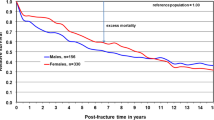Abstract
Hip fracture has repeatedly been associated with increases in the risks of death and pulmonary embolism (PE), but few studies have considered whether other fractures are also associated with these adverse outcomes. The authors estimated the 90-day risks and relative risks of mortality and PE after fractures, and the longer-term relative risks of mortality, for each of ten fracture sites. Using the 5% US standard sample of the Medicare population, we identified 81,181 fractures of the pelvis, patella, and long bones occurring between July 1, 1986, and June 30, 1990, among beneficiaries aged 65 years or older. The fractures were randomly matched by sex, race, and year of birth with a beneficiary who did not suffer that particular fracture, to form ten control cohorts. All patients were followed up until December 31, 1990. The 90-day risk of death was greater than 9% after hip, nonhip femur, and pelvic fractures, with risks relative to their matched control cohorts of 4.7 to 6.7. For white patients with these three fracture types these relative risks decreased substantially with age. White patients who had a hospitalization in the 2 years before hip fracture were more likely to die in the first 90 days than those who had no hospitalization before the hip fracture, but this effect, too, decreased with age. Patients who survived 1 year after most fracture types had no clinically significant excess mortality compared with their surviving controls. For patients with hip, nonhip femur, and pelvis fractures, however, there remained an elevated risk of 1.6 to 1.8, and for patients with proximal humerus fractures the risk ratio was 1.4. All lower-limb fractures carried a higher risk of PE than any upper-limb fracture.


Similar content being viewed by others
References
Katelaris AG, Cumming RG (1996) Health status before and mortality after hip fracture. Am J Public Health 86(4):557–560
Browner WS et al (1996) Mortality following fractures in older women: the study of osteoporotic fractures. Arch Intern Med 156(14):1521–1525
Cooper C et al (1993) Population-based study of survival after osteoporotic fractures. Am J Epidemiol 137(9):1001–1005
Wolinsky FD, Fitzgerald JF, Stump TE (1997) The effect of hip fracture on mortality, hospitalization, and functional status: a prospective study. Am J Public Health 87(3):398–403
Center JR et al (1999) Mortality after all major types of osteoporotic fracture in men and women: an observational study. Lancet 353(9156):878–882
Todd CJ et al (1995) Differences in mortality after fracture of hip: the east Anglian audit. BMJ 310(6984):904–908
White BL, Fisher WD, Laurin CA (1987) Rate of mortality for elderly patients after fracture of the hip in the 1980's. J Bone Joint Surg Am 69(9):1335–1340
Rossvoll I, Finsen V (1989) Mortality after pelvic fractures in the elderly. J Orthop Trauma 3(2):115–117
Montrey JS et al (1985) Thromboembolism following hip fracture. J Trauma-Injury Infect Crit Care 25(6):534–537
Lowe GDO et al (1992) THRIFT: risk of and prophylaxis for venous thromboembolism in hospital patients. BMJ 305(6853):567–574
MacMahon S et al (1994) Antiplatelet therapy to prevent thrombosis after hip fracture: rationale for a randomised trial. J Bone Joint Surg Br 76(4):521–524
Montgomery KD et al (1997) Practical management of venous thromboembolism following pelvic fractures. Orthop Clin North Am 28(3):397–404
Hjelmstedt A, Bergvall U (1968) Incidence of thrombosis in patients with tibial fractures. Acta Chir Scand 134(3):209–218
Tuttle-Newhall JE et al (1997) Statewide, population-based, time-series analysis of the frequency and outcome of pulmonary embolus in 318,554 trauma patients. J Trauma-Injury Infect Crit Care 42(1):90–99
Baron JA et al (1996) Basic epidemiology of fractures of the upper and lower limb among Americans over 65 years of age. Epidemiology 7(6):612–618
Kniffin WD Jr et al (1994) The epidemiology of diagnosed pulmonary embolism and deep venous thrombosis in the elderly. Arch Intern Med 154(8):861–866
Magaziner J et al (1989) Survival experience of aged hip fracture patients. Am J Public Health 79(3):274–278
Fisher ES et al (1992) The accuracy of Medicare's hospital claims data: progress has been made, but problems remain. Am J Public Health 82(2):243–248
Ray WA et al (1992) Identification of fractures from computerized Medicare files. J Clin Epidemiol 45(7):703–714
Acknowledgements
Supported in part by grant AG07146 from the National Institute on Aging, and in part by a grant from Merck pharmaceuticals.
Author information
Authors and Affiliations
Corresponding author
Rights and permissions
About this article
Cite this article
Barrett, J.A., Baron, J.A. & Beach, M.L. Mortality and pulmonary embolism after fracture in the elderly. Osteoporos Int 14, 889–894 (2003). https://doi.org/10.1007/s00198-003-1494-0
Received:
Accepted:
Published:
Issue Date:
DOI: https://doi.org/10.1007/s00198-003-1494-0




